Zoom
Trash

Women's Roles in 19th Century Australia Series: The Australian Colonies (Clickview) Sovereign Hill. The gold diggings Set in the Australian 1850s, the complex is located on a 25-hectare site that is linked to the richest alluvial gold rush in the world.
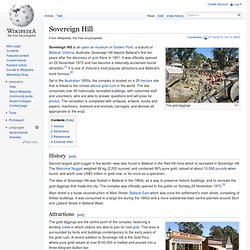
The site comprises over 60 historically recreated buildings, with costumed staff and volunteers, who are able to answer questions and will pose for photos. The recreation is completed with antiques, artwork, books and papers, machinery, livestock and animals, carriages, and devices all appropriate to the era2. History[edit] Gold Rush in Australia! The transportation of convicts to Australia was phased out between 1840 and 1868.
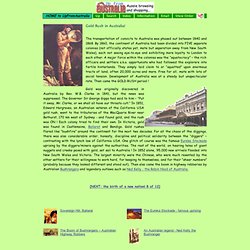
By 1860, the continent of Australia had been divided into FIVE separate colonies (not officially states yet, mate but seperation away from New South Wales), each not seeing eye-to-eye and exhibiting more loyalty to London to each other. A major force within the colonies was the “squatocracy” – the rich officers and settlers a.k.a. opportunists who had followed the explorers into fertile hinterlands. They simply laid claim to or “squatted” upon enormous tracts of land, often 20,000 acres and more. Free for all, mate with lots of social tension. Development of Australia was at a steady but unspectacular rate. Gold was originally discovered in Australia by Rev. Events and Aftermath of the Eureka Stockade Series: The Australian Colonies (Clickview)
Gold rush. Sailing to California at the beginning of the Gold Rush A gold rush is a period of feverish migration of workers to an area that has had a dramatic discovery of gold deposits.
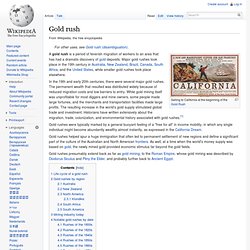
Major gold rushes took place in the 19th century in Australia, New Zealand, Brazil, Canada, South Africa, and the United States, while smaller gold rushes took place elsewhere. In the 19th and early 20th centuries, there were several major gold rushes. The permanent wealth that resulted was distributed widely because of reduced migration costs and low barriers to entry. While gold mining itself was unprofitable for most diggers and mine owners, some people made large fortunes, and the merchants and transportation facilities made large profits. Gold rushes were typically marked by a general buoyant feeling of a "free for all" in income mobility, in which any single individual might become abundantly wealthy almost instantly, as expressed in the California Dream. Life cycle of a gold rush[edit] Australia[edit]
The Australian Gold Rush. Www.patricktaylor.com | articles First published April 28th, 2006.
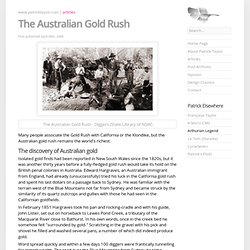
Events Leading up to the Eureka Stockade Series: The Australian Colonies (Clickview) Events Leading up to the Eureka Stockade Series: The Australian Colonies (Clickview) Australian Bushrangers (Years 4-6) (Clickview) Australian Crimes - BUSHRANGERS. Early Australian bushrangers. McFarlane & Erskine, Gold escort attacked by bushrangers, 187-, print: lithograph.
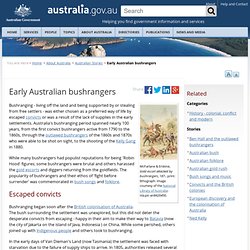
Image courtesy of the : nla.pic-an8420450. Bushranging - living off the land and being supported by or stealing from free settlers - was either chosen as a preferred way of life by escaped or was a result of the lack of supplies in the early settlements. Australian Bushrangers. Ned Kelly. Edward "Ned" Kelly (December 1854[1] – 11 November 1880) was an Australian bushranger of Irish descent.

Kelly was born in the town of Beveridge in the British colony of Victoria to an Irish convict from County Tipperary and an Australian mother with Irish parentage. When Kelly was 12, his father died after a six-month stint in prison for unlawful possession of a bullock hide. After being indicted for the attempted murder of a police officer at his family's home in 1878, policemen and native trackers scoured the bush for Kelly and those accused with him. After he, his brother, and two associates fatally shot three policemen, the Government of Victoria proclaimed them as outlaws. During the remainder of "The Kelly Outbreak", Kelly and his associates committed numerous armed robberies and fatally shot Aaron Sherritt, a known police informant. A final violent confrontation between the Kelly Gang and the Victoria Police took place at Glenrowan on 28 June 1880. Bushrangers: John Dunn.
"Through the influence of his grandfather, Dunn was invited to join Ben Hall and John Gilbert's bushranging gang.
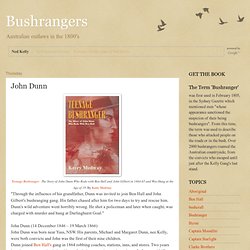
His father chased after him for two days to try and rescue him. Dunn's wild adventure went horribly wrong. He shot a policeman and later when caught, was charged with murder and hung at Darlinghurst Goal. " John Dunn (14 December 1846 – 19 March 1866) John Dunn was born near Yass, NSW. John Dunn (bushranger) Memorial to Nelson at Collector Inscription on memorial to Nelson John Dunn (14 December 1846 – 19 March 1866) was an Australian bushranger.
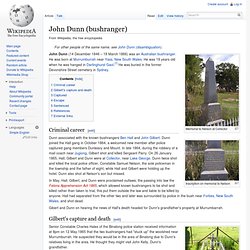
He was born at Murrumburrah near Yass, New South Wales. He was 19 years old when he was hanged in Darlinghurst Gaol.[1] He was buried in the former Devonshire Street cemetery in Sydney. In May, Hall, Gilbert, and Dunn were proclaimed outlaws; the passing into law the Felons Apprehension Act 1865, which allowed known bushrangers to be shot and killed rather than taken to trial, this put them outside the law and liable to be killed by anyone.
Gibert and Dunn on hearing the news of Hall's death headed for Dunn's grandfather's property at Murrumbarrah. Gilbert's grave near Binalong. Crime and Punishment in the Colony Series: The Australian Colonies (Clickview)